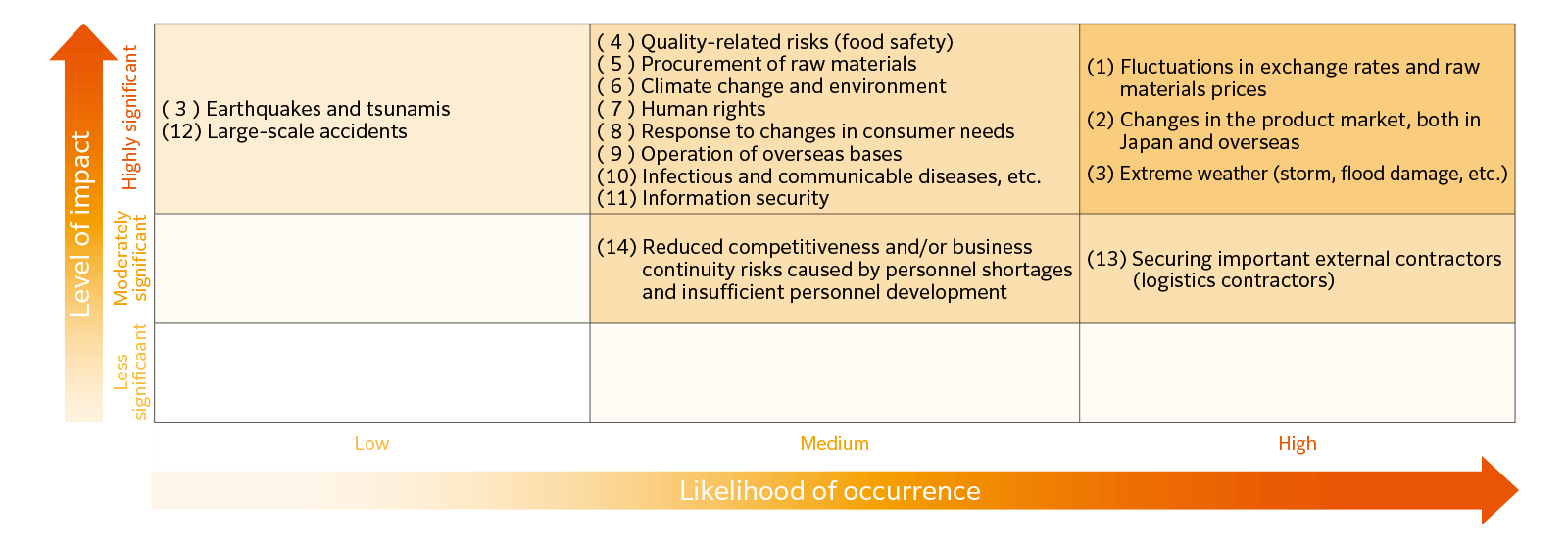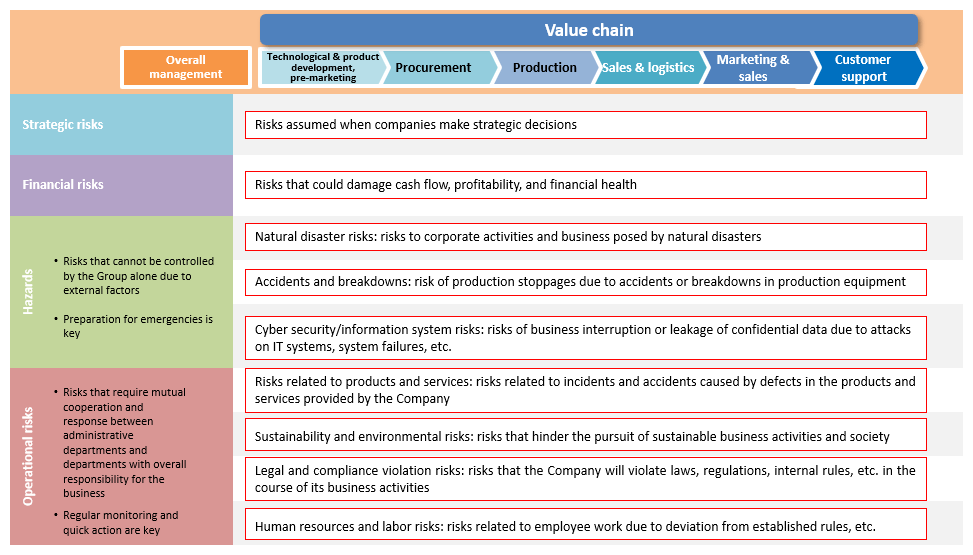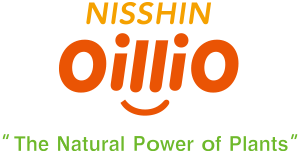

- Nisshin OilliO HOME
- Investor Relations
- Management Policy/System
- Business Risks
Business Risks (Updated on )
Approach to risk management
The Group defines uncertainties that will have a negative impact on the achievement of the corporate vision in its Vision 2030 and medium-term business plan Value UpX, as well as its business end eavors as “risks,” and carries out risk control efforts to mitigate these risks. Through independent risk management efforts, the goal of the Group is to not only generate stable revenue as a company, but also to further increase and develop its corporate value through fulfilling its social responsibilities.
Material risks
The content herein highlights the Group’s material risks selected by the Risk Management Committee from the risk matrix.
Risk matrix (Material risks identified)

Initiatives to strengthen risk management system
In light of recent changes in the business environment, we are working to strengthen our risk management system.
Key points of our initiatives
- • We have changed to a system in which administrative departments and departments with overall responsibility for the business collaborate closely to deal with material risks.
Administrative departments: deal with risks that arise directly in connection with the execution of own operations. Departments with overall responsibility for the business: manage risks in specialized areas that arise throughout the organization or across multiple related departments. - • In order to comprehensively identify and classify risks, we have created a new matrix diagram based on two axes: four types of risks (vertical axis) and value chains (horizontal axis). We are rolling this out across the entire group and re-conducting a comprehensive review of risks within each department.
Furthermore, risks related to legal compliance are classified as risks equivalent to material risks and are addressed through measures such as training to raise awareness throughout the Group. These risk items are scheduled to be added to the material risks of the Group for FY2025.
Risk matrix diagram

Descriptions of material risks incurred by the Group and measures for addressing such risks are as follows.
Whereas the following content includes contingencies, these contingencies have been identified by the Group as having relevancy as of the end of the current fiscal year.
1. Fluctuations in exchange rates and raw materials prices
Description of material risks
In its oil & fat business and processed food & materials business, the Group imports all of its raw materials from overseas, including soybeans, rapeseed, and cacao. It has also extended its overseas operations in Malaysia, elsewhere in Southeast Asia, and Europe. The Group accordingly assumes the risk of exchange rate volatility particularly associated with raw material costs, sales in foreign currencies, and borrowings in foreign currencies. Such exchange rate volatility could potentially affect its business performance and financial position.
As for raw materials, in addition to the risk of market volatility with respect to international prices of raw materials, we also assume the risk of volatility in transportation costs and other expenditures potentially resulting from soaring crude oil prices. Raw materials prices could potentially affect the Group’s business performance and financial position given that they constitute a key component of its cost structure.
Addressing such risks
The Group addresses such risks by flexibly arranging forward exchange contracts and hedging transactions enlisting futures markets, in accordance with the management rules for derivatives, commodity futures, etc. and other internal rules. With regard to hedging transactions, we also share and monitor information on a quarterly basis in meetings of the Board of Corporate Officers.
Furthermore, the Group is taking efforts to curb the impact of cost fluctuations by optimizing its sales prices to align with the cost of raw materials, as well as reducing its manufacturing costs and other expenses.
2. Changes in the product market, both in Japan and overseas
Description of material risks
Sales of the oil & fat business are especially prone to changes in product market conditions in Japan and overseas. Domestic selling prices of oils, fats and meal products generally hinge on international market conditions.
In addition, trends with respect to product imports from overseas could potentially affect sales prices in Japan. As such, a scenario where such changes arise with respect to market conditions in Japan and overseas could affect the Group’s business performance and financial position.
Addressing such risks
The Group strives to sell its products at fair prices that align with costs and the like according to the fluctuations in product market conditions in Japan and overseas.
The Group is engaging in efforts to scale its sales of high-value-added products, gradually increasing its percentage of sales of such products. While sometimes time lags may occur from fluctuations in the cost of goods sold and sales prices, the Group strives to reduce the impact of this risk on its business performance.
The Board of Corporate Officers manages the progress of the business plan every month and feeds the results into the implementation of necessary measures.
3. Earthquakes, tsunamis, and extreme weather (storm, flood damage, etc.)
Description of material risks
In addition to the threat of earthquakes and tsunamis, we are well aware that risks involving recent events such as storm and flood damage due to extreme weather have been increasing from one year to the next. Should damage occur to employee safety, manufacturing facilities at production sites, logistics systems, or infrastructure due to such risks, disruptions to key points in the supply chain could hinder the stable supply of products, potentially impacting the Group’s business performance and financial position.
Addressing such risks
The Group adopted a safety confirmation system designed to check on the safety of employees and others in the event of an earthquake, tsunami, or other such disaster. We have also established a business continuity plan (BCP) that we review as necessary to enhance its effectiveness. At the same time, the Group is proceeding with necessary efforts involving the seismic reinforcement of facilities for the safety of its employees, etc., as well as the enhancement of its production system foundations. The Group is also enhancing its earthquake countermeasures in terms of its embankments and its procurement of electrical power.
We regularly conduct comprehensive disaster readiness drills and training, while recognizing the mitigation of risks from storm and flood damage caused by extreme weather events in recent years as a critical challenge and promoting disaster reduction initiatives.
We also continuously assess events with significant impacts beyond these measures, striving to minimize damage as much as possible, provide insurance coverage, and reduce the impact on our Group’s business performance and financial position.
4. Quality-related risks (food safety)
Description of material risks
Growing social concern when it comes to food quality and safety has given rise to the need for more stringent systems of quality control. Accordingly, the Group’s credibility, business performance, and financial position could be adversely affected should a situation arise involving quality concerns.
Addressing such risks
The Quality Management Committee of the Group, which serves as an advisory body to the Board of Corporate Officers, deliberates on and checks the implementation of policies and measures involving quality assurance. Our major plants in Japan have obtained ISO 9001 certification and FSSC 22000, an international standard for food safety management. Additionally, we have established rigorous quality assurance systems, including GMPs.
5. Procurement of raw materials
Description of material risks
Among the raw materials required for the Group’s products, the oil & fat business and processed food & materials business in particular must procure primary raw materials such as soybeans, rapeseed, and cacao, along with oils and fats such as olive oil and palm oil. Accordingly, deterioration of the environment for procuring such raw materials causing an inability to procure sufficient amounts of raw materials or secure raw materials that meet the Group’s requirements for quality and safety could result in tremendous risks to stable product supply, thereby affecting the Group’s credibility, business performance, and financial position.
The sense of uncertainty over the supply and demand for food supplies due to an increase in the world’s population and abnormal weather, etc., occurring frequently in each region of the globe continues to grow year on year. Meanwhile, political trends in countries where the Group’s raw materials are produced and increasing geopolitical risks and so on also present the risk of raw material supplies becoming unstable. As a result, great care must be paid to this risk.
Addressing such risks
In order to address changes in the procurement environment of raw materials brought about by factors such as the impact of extreme weather (e.g., droughts), political trends in production countries, and increasing geopolitical risks, the Group strives to ensure stable procurement by diversifying the production countries and suppliers of raw materials.
Particularly in circumstances where trends in the procurement environment are difficult to predict, the Group strives to procure with a vision of demand up to the next procurement period to ensure inventory.
Moreover, with the aim of procuring safe raw materials, we conduct safety assessments involving analysis and on-site visits when purchasing raw materials from new production regions and suppliers. In addition, with respect to raw materials purchased through existing channels, we regularly conduct safety assessments and collect information on their origins, thereby securing safe and reliable raw materials.
6. Climate change and environment
Description of material risks
Contemporary issues attracting attention include measures to address global warming and marine plastic waste. Accordingly, an inability to address such challenges could adversely affect the Group’s credibility, business performance, and financial position.
Addressing such risks
The Group, which positions plant resources at the heart of its business endeavors, believes the preservation of the global environment and its resources is integral to keeping the company in business for years to come, and thus engaged in the following initiatives to achieve a decarbonized and recycling-oriented society.
Addressing climate change
- • We updated our decarbonization roadmap in line with increased CO₂ emissions reduction target for FY2030.
- • We reduced our Scope 1 and 2 CO₂ emissions in FY2024 by 20.7% (preliminary figure, compared to FY2016) by investing in new facilities introduced at our domestic production bases and purchasing more green energy at ISF.
- • As part of efforts to achieve 1% hydrogen co-firing by 2030, we upgraded the cogeneration system at the Yokohama Isogo Plant.
Environmentally conscious efforts
- • We disclosed information based on TNFD recommendations.
Reduce use of plastic containers and packaging
- • We conducted a demonstration experiment on the collection of used oil-containing PET bottles in collaboration with Kewpie Corporation.
- • We have redesigned our fresh-keep bottles (plastic use reduced by approximately 19%; cap seal easier to remove).
- • To reduce plastic use, we have expanded the use of recycled PET resin.
7. Human rights
Description of material risks
If the Group or a supplier causes a human rights problem or procures in a way that is problematic in terms of human rights, this could impact the Group’s credibility, business performance, and financial position.
Addressing such risks
In FY2024, we conducted human rights due diligence on suppliers of key raw materials with high priority, such as soybeans, rapeseed, and palm oil, and on logistics-related business partners that are important for the supply of our Group’s products, taking into account human rights risks.
In FY2025, we will expand the scope of our SAQ surveys and supplier dialogue, and work to establish a system for conducting human rights due diligence on an ongoing basis.
8. Response to changes in consumer needs
Description of material risks
Changes in consumer needs in recent years have been extremely quick and become increasingly diverse, with consumer needs potentially changing before the Group is even aware of them. There is also the possibility that the Group cannot meet the needs even if it is aware of them, which may impact the Group’s business performance and financial position.
Addressing such risks
The Group constantly strives to grasp changes in consumer needs as soon as possible, and has, for example, taken the following actions.
Olives, the raw material for olive oil, have experienced record-breaking production declines in Europe, the main producing region, for two consecutive years in 2022 and 2023 due to high temperatures and low rainfall. As a result, olive oil prices have surged globally. Despite this challenging environment, we have launched a small-sized Nisshin Light and Smooth Olive Oil to allow consumers to enjoy the delicious taste and health benefits of olive oil.
In addition, in response to the growing health consciousness in recent years and the expansion of the rice bran oil market, we have launched Nisshin Rice Bran Oil 1300 g, a large-capacity version of the original product.
As part of our efforts to strengthen customer contact points, we have established a Bangkok representative office as a marketing base in Southeast Asia with the aim of developing the cosmetic ingredients market in the fine chemical business.
9. Operation of overseas bases
Description of material risks
The Group has been expanding its business not only within Japan but also in Southeast Asia, Europe and elsewhere. The following scenarios pose risks, particularly when it comes to overseas business development.
- i. Unexpected enactment, revision or abolishment of laws and regulations
- ii. Occurrence of unforeseen political and economic developments
- iii. Social turmoil and other geopolitical risks due to terrorism, strife and other such developments
If these events occur, they may impact the Group’s business performance and financial position.
Addressing such risks
To minimize such risks, the Group will endeavor to collect information and respond accurately and promptly within the crisis management structure by coordinating with Group companies in each country or region.
10. Infectious and communicable diseases, etc.
Description of material risks
The Group’s business performance and financial position could be adversely affected amid a potential scenario where key points of the supply chain become subject to the effects of the prevalence of communicable diseases, infectious diseases or other such developments; contagion of employees or others; restrictions imposed on business activities including those of outsourcers; or insufficient procurement of raw materials, disrupting the stable supply of products as a result. The Group’s business performance and financial position could also be adversely affected should product demand become subject to significant volatility.
Addressing such risks
We reviewed our company’s measures (actual results) in response to the COVID-19 pandemic and drafted revisions to our BCP documents related to infectious diseases, reflecting the contents of the “National Action Plan for Novel Influenza and Other Infectious Diseases” and the “Guidelines for Measures Against Novel Influenza and Other Infectious Diseases in Workplaces and by Businesses.”
11. Information security
Description of material risks
The Group has established information systems for the purposes of achieving smooth and efficient execution of business operations encompassing production, logistics and sales management, as well as finance and accounting. We also retain material business information along with confidential and personal information gained in the course of doing business. In the event business delays and data breaches associated with potential system disruptions caused by major disasters, power outages, computer viruses, or cyberattacks, the Group may lose the credibility of its customers and the market, ultimately impacting the Group’s business performance and financial position.
Addressing such risks
In order to secure stable operation of the Group’s information systems, improve its credibility, and prevent data breaches, the Group has taken action that includes adopting tool-based security measures, conducting employee education and training, and taking steps to ensure that risks do not materialize.
Furthermore, the Group has put in place response manuals and a communication structure in preparation for security incidents.
The Information Security Committee receives regular reports on information security measures and conducts evaluations and reviews.
12. Large-scale accidents
Description of material risks
If large-scale accidents such as fires or explosions occur, they will disrupt the stable supply of products and may impact the Group’s credibility, business performance, and financial position.
Addressing such risks
In addition to appointing an officer in charge of safety and disaster prevention who is responsible for overseeing company-wide safety and disaster-prevention management, we have established a company-wide disaster prevention system, centered on a safety and disaster-prevention committee, as well as a disaster-prevention system for our business operations.
Furthermore, in addition to stipulating a system in case of emergencies, we regularly hold general disaster drills and educational training, striving to prevent accidents as well as prepare ourselves in the unlikely event that one might occur.
The Group strives to reduce the impact of this risk on its business performance and financial position by carrying out the aforementioned efforts and retaining insurance coverage.
13. Securing important external contractors (logistics contractors)
Description of important risks
We strive to ensure our access to requisite logistical capabilities at appropriate cost so that we are able to deliver products to our customers in line with their requests. However, in the event the Group is unable to carry it out, the supply of products to customers will be delayed, and it could impact the Group’s business performance and financial position.
In Japan, there is a shortage of truck drivers, including tank truck drivers, and the aging of the workforce is progressing. As a result, there is a possibility that freight capacity will decrease in the future, raising concerns about a logistics supply-demand gap. Furthermore, delays in improving various logistics issues unique to the food industry, such as long waiting times and delivery-related tasks, pose the risk of not being able to deliver products to customers.
Similarly, there is concern that a shortage of crew members and an aging workforce will lead to a gap between supply and demand in logistics for domestic shipping.
Addressing such risks
The Group is taking measures such as reviewing delivery lead times, reviewing and expanding shipping bases, and securing alternative transportation methods such as rail and ship for products in the household-use and commercial-use areas of the oil & fat business. We are also working to reduce logistics risks by promoting sustainable logistics initiatives and optimizing shipping costs. In FY2024, in addition to efforts to achieve the CSV goals set in the previous fiscal year (i.e., expanding the co-distribution function ratio, reducing truck driver working hours, etc.), we have also made progress in introducing a supply and demand management system and a truck driver working hours management system.
In addition, we are promoting joint delivery and logistics improvement initiatives through a logistics company funded by five food manufacturers.
Going forward, the Group will continue to examine initiatives to optimize the entire supply chain through the use of digital technologies, in pursuit of achieving “local production for local consumption,” whereby the Group delivers products that have been manufactured at factories situated in closer proximity to the site of consumption.
14. Reduced competitiveness and/or business continuity risks caused by personnel shortages and insufficient personnel development
Description of material risks
Professional talent equipped with diverse values and expertise is a must in achieving the vision set forth under The Nisshin OilliO Group Vision 2030. Meanwhile, a shortage of such talent would result in diminished competitiveness.
On the other hand, when it comes to the notion of consistently providing safe and reliable products, we are particularly aware that a prospective shortage of talent tasked with activities involving production and distribution sites constitutes a major risk in terms of our business continuity.
In addition, personal health is the most important factor for each and every employee to achieve personal and professional fulfillment, while also persistently demonstrating their potential enthusiastically within the Group. Our exposure to employee health risk could adversely affect productivity and other aspects of operations.
Addressing such risks
The Group is taking further action to secure and reinforce requisite professional talent by focusing efforts on creating a vibrant organization that gives rise to innovation. This involves valuing employee diversity, increasing investment in human resource development programs that enable each and every individual to grow, recruiting talent from outside the Group as necessary, empowering female employees, and promoting health management.
The Group’s efforts to consistently provide safe and reliable products involve taking steps to secure and retain professional talent in part through ongoing recruitment and training, actively utilizing remote work, and optimizing working conditions. The Group also streamlines operations and achieves labor savings by enlisting IoT, AI, and other such technologies.
Having established a framework for promoting health management, to which top management holds the ultimate authority, the Group engages in various health management initiatives for the purposes of achieving better physical and mental health for employees, job satisfaction, and productivity gains.



